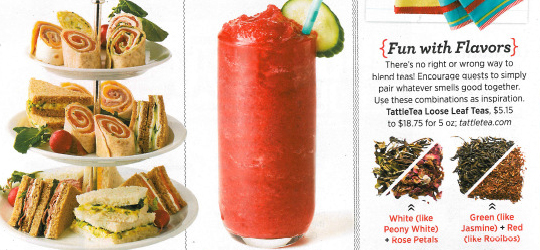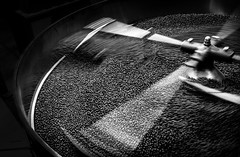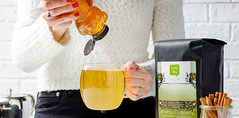Loose Leaf Iced Tea: You can brew it!
Friday, July 11th, 2014 by Andrew
For most tea drinkers (in this country anyway), tea equals tea bags. Unless you’ve happened upon a bum bag, you may have never seen what’s inside. And if you have had one bust open, you probably think that tea is a dusty mess. If your pursuit of a better cup has led you to loose leaf teas, you know that’s not so. Whole tea leaves are quite a bit larger than anything you will find in a tea bag. Why is this important? The aromatic oils responsible for flavor evaporate quickly when tea leaves are broken. Whole leaves retain their flavor longer and a larger bag, or no bag at all means they are free to fully expand and express themselves (yield flavor and brew a delicious cup).
If you are a loose leaf convert, you probably know how to brew your favorite teas. If you don’t, we tried to make it simple on our Tattle Tea site by providing some general guidelines as well as specific brewing instructions for each tea, including amount of tea, ideal water temperature and steep time. But that’s per cup, hot. How does that translate to iced, especially if you’re used to throwing a bunch of teabags in a pitcher?
How to Brew Loose Leaf Iced Tea
Green, white, herbal, flavored — if you like it hot, try it iced. The hot water method may be the easiest place to start. This method creates a concentrated shot of hot tea you can then pour over ice and serve immediately. Start by calculating how much tea you would need to brew 16 oz double-strength (our instruction on the site and our packaging are for 8 oz, so double the tea quantity). 8 oz of hot Orange Pekoe, for example, requires 1.5 tsp of tea leaves. 16 oz would be 3 tsp, or 6 tsp for a double strength batch. Now, if you will be pouring this over ice, so you only need about 4 oz of hot water total to account for ice melt. That means you will be brewing 6 tsp in 4 oz of near-boiling water. The steep time and water temperature is the same as for regular hot tea, regardless of strength or quantity. Here’s the recipe:
16 oz. Iced Orange Pekoe
- Place 6 tsp of loose leaf black tea into an infuser or disposable tea bag
- Add 4 oz. of near-boiling water
- Steep for 3.5 minutes
- Remove tea and add sweetener
- Pour over a 16 oz glass of ice and serve
For larger quantities, the same tea: hot water: ice ratio applies, just adjust your amounts accordingly.
1 Gallon Iced Orange Pekoe
- In a 1 gal. pitcher, add 1 dry measuring cup of loose leaf black tea to an infuser or large tea bag (if infuser is not large enough, leave tea loose in the pitcher and pour through a strainer later)
- Add two quarts of near-boiling water
- Steep for 3.5 minutes
- Remove tea and add sweetener
- Add ice until the pitcher is full
- Tea is ready to be served or stored in a refrigerator or freezer and served as needed
Cold Steeping Convenience
As always, a little bit of planning can make life so much easier. The beauty of cold steeping is that the tea will never over-steep and become bitter, which is often a problem for green teas and anyone forgetful in the kitchen. Also, the ratio of tea:water needed is the same as for hot tea, which makes it the better choice for the math-impaired.*
There are dozens of cold steep jugs available. The Mist Iced Tea Jug works well for loose leaf tea because it has a tea strainer built into the spout, so no infusers or tea bags are necessary. Cold steeping takes time – overnight is best. There is something about cold steeping that makes me want to get creative. Add some herbs or fruit to the jug and allow it all to infuse together.
50 oz Iced Orange Pekoe
- Add 3 heaping tablespoons of black tea to the a 50 oz. iced tea jug
- Fill with water
- Leave in refrigerator overnight or for minimum of 8 hours
- Sweeten if desired. Simple syrup mixes easily with cold tea
- When ready to serve, pour over ice
*Since the tea will already be cold, it is unnecessary to compensate for ice melt with extra tea or with less water.
For most tea drinkers (in this country anyway), tea equals tea bags. Unless you’ve happened upon a bum bag, you may have never seen what’s inside. And if you have had one bust open, you probably think that tea is a dusty mess. If your pursuit of a better cup has led you to loose leaf teas, you know that’s not so. Whole tea leaves are quite a bit larger than anything you will find in a tea bag. Why is this important? The aromatic oils responsible for flavor evaporate quickly when tea leaves are broken. Whole leaves retain their flavor longer and a larger bag, or no bag at all means they are free to fully expand and express themselves (yield flavor and brew a delicious cup).
If you are a loose leaf convert, you probably know how to brew your favorite teas. If you don’t, we tried to make it simple on our Tattle Tea site by providing some general guidelines as well as specific brewing instructions for each tea, including amount of tea, ideal water temperature and steep time. But that’s per cup, hot. How does that translate to iced, especially if you’re used to throwing a bunch of teabags in a pitcher?
How to Brew Loose Leaf Iced Tea
Green, white, herbal, flavored — if you like it hot, try it iced. The hot water method may be the easiest place to start. This method creates a concentrated shot of hot tea you can then pour over ice and serve immediately. Start by calculating how much tea you would need to brew 16 oz double-strength (our instruction on the site and our packaging are for 8 oz, so double the tea quantity). 8 oz of hot Orange Pekoe, for example, requires 1.5 tsp of tea leaves. 16 oz would be 3 tsp, or 6 tsp for a double strength batch. Now, if you will be pouring this over ice, so you only need about 4 oz of hot water total to account for ice melt. That means you will be brewing 6 tsp in 4 oz of near-boiling water. The steep time and water temperature is the same as for regular hot tea, regardless of strength or quantity. Here’s the recipe:
16 oz. Iced Orange Pekoe
- Place 6 tsp of loose leaf black tea into an infuser or disposable tea bag
- Add 4 oz. of near-boiling water
- Steep for 3.5 minutes
- Remove tea and add sweetener
- Pour over a 16 oz glass of ice and serve
For larger quantities, the same tea: hot water: ice ratio applies, just adjust your amounts accordingly.
1 Gallon Iced Orange Pekoe
- In a 1 gal. pitcher, add 1 dry measuring cup of loose leaf black tea to an infuser or large tea bag (if infuser is not large enough, leave tea loose in the pitcher and pour through a strainer later)
- Add two quarts of near-boiling water
- Steep for 3.5 minutes
- Remove tea and add sweetener
- Add ice until the pitcher is full
- Tea is ready to be served or stored in a refrigerator or freezer and served as needed
Cold Steeping Convenience
As always, a little bit of planning can make life so much easier. The beauty of cold steeping is that the tea will never over-steep and become bitter, which is often a problem for green teas and anyone forgetful in the kitchen. Also, the ratio of tea:water needed is the same as for hot tea, which makes it the better choice for the math-impaired.*
There are dozens of cold steep jugs available. The Mist Iced Tea Jug works well for loose leaf tea because it has a tea strainer built into the spout, so no infusers or tea bags are necessary. Cold steeping takes time – overnight is best. There is something about cold steeping that makes me want to get creative. Add some herbs or fruit to the jug and allow it all to infuse together.
50 oz Iced Orange Pekoe
- Add 3 heaping tablespoons of black tea to the a 50 oz. iced tea jug
- Fill with water
- Leave in refrigerator overnight or for minimum of 8 hours
- Sweeten if desired. Simple syrup mixes easily with cold tea
- When ready to serve, pour over ice
*Since the tea will already be cold, it is unnecessary to compensate for ice melt with extra tea or with less water.






















